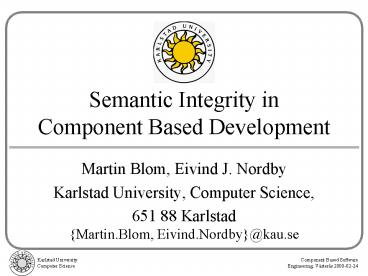Semantic Integrity in Component Based Development - PowerPoint PPT Presentation
Title:
Semantic Integrity in Component Based Development
Description:
Component Based Development Martin Blom, Eivind J. Nordby Karlstad University, Computer Science, 651 88 Karlstad {Martin.Blom, Eivind.Nordby}_at_kau.se – PowerPoint PPT presentation
Number of Views:122
Avg rating:3.0/5.0
Title: Semantic Integrity in Component Based Development
1
Semantic Integrity in Component Based Development
- Martin Blom, Eivind J. Nordby
- Karlstad University, Computer Science,
- 651 88 KarlstadMartin.Blom, Eivind.Nordby_at_kau.s
e
2
Motivation and Objectives
- Component technology promotes a flexible
combination of software parts - developed by third parties
- used in different environments
- spread out across a network
- no source code available
- Requires a lot from both syntactic and semantic
descriptions - Our goal Investigate how semantic aspects are
managed for components
3
Semantic Integrity and Contracts
- Semantic integrity
- Each part of a software system respects the
intended purpose of any other individual part of
that system. - Contract
- An agreement of conditions for use between a
client and a supplier - The client is obliged to satisfy the contracts
precondition - In that case only, the supplier is bound by the
contracts postcondition - Expressed strictly in externally observable terms
4
Literature Searches
- Where
- Recent issues of scientific and engineering
proceedings and communications - IEEE, ACM, Elsevier, Springer
- For what
- Semantic, integrity, semantic description,
software, component, interface, interface
definition, contract
5
Our Findings (1)
- Semantic integrity mostly used with databases
- Component definitions mostly concerned with
syntax - Interface Description Languages
- Consensus that syntax is not enough to describe a
component
6
Our Findings (2)
- Semantic relationships discussed
- in intuitive terms not alter the service
expectations - with programming constructs OCL, assertions
- most often executable statements
- in formal terms provable correctness
- takes competence, time and resources
- Contract often used to describe semantics
- sometimes used to imply syntax only
7
Focuses from the survey
Abstraction level
High
Semantic awareness
Formal
Executable
Pragmatic
Intuitive
None
Low
Definition
Reuse
Maintenance
Life cycle stage
8
Missing focus
Abstraction level
High
Semantic awareness
Formal
Executable
Pragmatic
Intuitive
None
Low
Definition
Reuse
Maintenance
Life cycle stage
9
Thank you for your attention!Are there any
questions?
- Martin Blom, Eivind J. Nordby
- Karlstad University, Computer Science,
- 651 88 KarlstadMartin.Blom, Eivind.Nordby_at_kau.s
e































